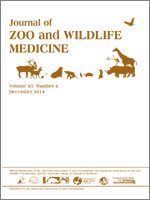Wounds in reptiles are a common reason for presentation to a veterinarian. At this time there is limited information on effective topical medications to aid in wound closure. The objectives of this study were to translate the splinted, full-thickness dermal wound model, validated in mice, to the bearded dragon (Pogona vitticeps) and to determine the effect of topical becaplermin (BP), a platelet-derived growth factor (0.01%), on the rate of wound closure. Ten bearded dragons were anesthetized and two full-thickness cutaneous wounds were made on the dorsum of each lizard. Encircling splints were applied surrounding each wound and subsequently covered by a semi-occlusive dressing. Five lizards had one wound treated with BP and the adjacent wound treated with a vehicle control. Five additional lizards had one wound treated with saline and the second wound treated with a vehicle control. Wounds were imaged daily, and the wound area was measured using digital image analysis. The change in percentage wound closure over 17 days and the time to 50% wound closure was compared among the four treatment groups. There was no significant difference in wound closure rates between BP-treated and saline-treated wounds or in the time to 50% wound closure between any treatments. Vehicle-treated wounds adjacent to saline-treated wounds closed significantly slower than did BP (P < 0.010), saline (P < 0.001), and vehicle-treated wounds adjacent to BP-treated wounds (P < 0.013). Our preliminary study indicates that the splinted wound model, with modifications, may be used to determine wound closure rates in bearded dragons. When compared with saline, BP did not have a significant effect on wound closure rates, while the vehicle alone delayed wound closure. Histologic analysis of experimentally created wounds throughout the wound healing process is needed to further evaluate the effects of these treatments on reptile dermal wound healing.
How to translate text using browser tools
1 December 2014
ASSESSMENT OF PLATELET-DERIVED GROWTH FACTOR USING A SPLINTED FULL THICKNESS DERMAL WOUND MODEL IN BEARDED DRAGONS (POGONA VITTICEPS)
Krista A. Keller,
Joanne Paul-Murphy,
Scott Weber,
Philip H. Kass,
David Sanchez-Migallon Guzman,
Shin Ae Park,
Vijay Krishna Raghunathan,
Kate A. Gustavsen,
Christopher J. Murphy
ACCESS THE FULL ARTICLE
bearded dragon
becaplermin
healing
Pogona vitticeps
wound





